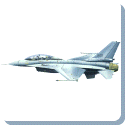 F-16 Fighting Falcon — F-16 Fighting Falcon fighter-bomber aircraft is the mainstay of the U.S. Air Force as well as of the air forces of several NATO and non-NATO allies. The single-seat F-16A fighter and the two-seater F-16B fighter/trainer are the basic configurations of this versatile aircraft.
F-16 Fighting Falcon — F-16 Fighting Falcon fighter-bomber aircraft is the mainstay of the U.S. Air Force as well as of the air forces of several NATO and non-NATO allies. The single-seat F-16A fighter and the two-seater F-16B fighter/trainer are the basic configurations of this versatile aircraft.
The F-16 Fighting Falcon is an American multirole jet fighter aircraft developed by General Dynamics and Lockheed Martin for the United States Air Force. Designed as a lightweight fighter, it evolved into a successful multirole aircraft. The Falcon’s versatility is a paramount reason it was a success on the export market, serving 24 countries. The F-16 is the largest Western fighter program with over 4,000 aircraft built since production started in 1976. Though no longer produced for the US Air Force, it is still produced for export.
The Fighting Falcon is a dogfighter with innovations including a frameless, bubble canopy for better visibility, side-mounted control stick to ease control while under high g-forces, and reclined seat to reduce the effect of g-forces on the pilot. It was also the first fighter aircraft to be deliberately built to sustain 9g turns. It is also one of the few jets with a thrust-to-weight ratio greater than one, giving the Falcon excellent acceleration.
Although the F-16’s official name is “Fighting Falcon”, it is known to its pilots as the “Viper”, after the Battlestar Galactica starfighter.
In 1993, General Dynamics sold its aircraft manufacturing business to the Lockheed Corporation, which in turn became part of Lockheed Martin after a 1995 merger with Martin Marietta
Development
During the 1960s the U.S. Air Force and Navy both concluded that the future of air combat would be determined by increasingly sophisticated missiles. Future “fighters” would be designed primarily for long range, high speed, and equipped with extremely large radar systems in order to detect opposing fighters at long range. This made them much more like interceptors than classic fighter designs. In the early 1960s both the Air Force and Navy expected to use the F-111 (then still in development as the TFX) and F-4 Phantoms for their long and medium range needs complemented by several single-engine designs including upgraded F-100 Super Sabres, F-104 Starfighters, and F-8 Crusaders. Future twin-engine fighter programs were getting underway and the Air Force began a replacement for its single-engine fighter designs to maintain its high-low mix of air superiority aircraft.
F-16CG Fighting Falcon at Paris Air Show 2007 Real-world experience in the Vietnam War showed the continued need for the ‘high-low’ fighter matrix system. Soviet-bloc fighters over Vietnam were proving to be more of a problem than expected for US designs. Even though the US had very large kills to losses ratio in its favor, combat revealed some shortcomings. Missiles of this era still had notable reliability issues, and restrictions on how they were functionally used. Combat invariably closed to short ranges where air-combat maneuverability and short range air-air weapons became critical. Dedicated interceptors like the F-102 Delta Dagger had also been tested in combat which revealed certain shortcomings. Although US training, doctrine and air control more than made up for these disadvantages, it was nevertheless clear to some in the Air Force that the all-missile doctrine was seriously flawed. Both aircraft of the future high-low mix for the USAF would have guns (F-15 and F-16).
In particular, Colonel John Boyd developed the theory of energy maintenance in fighter combat, which relied on larger wings in order to preserve maneuverability. Larger wings would mean more drag in flight, usually resulting in lower range and slower top speed (although larger wings can also result in greater range due to increased payload and fuel). He felt this was a fair trade-off for a “real” fighter design. At about this time the navalized F-111 was running into serious problems, and was eventually abandoned in favor of a new design, the F-14 Tomcat. A combination of Boyd’s tireless advocacy of maneuverability, and what is often viewed as a failure of the F-111 to develop into a suitable fighter, and notably the rather over-inflated performance estimates of the MiG-25 led the USAF to also start development of their own fighter design, the F-15 Eagle.
It was not long before the F-15 started growing into a very large design that appeared to be turning into an “F-111 mark II”. Boyd was frustrated by this development, and convinced a number of others that the F-15 would need to be complemented by larger numbers of smaller fighters like previous twin-engine fighters. A group of interested parties formed the self-named “fighter mafia” and agitated for the development of the Light Weight Fighter. They eventually won a small amount of money, only $149,000 (~$715,000 year 2000 dollars) to conduct studies into such a design. Northrop had always been a proponent of light-weight designs and had continually developed plans for an advanced F-5 Freedom Fighter, and received $100,000. General Dynamics, looking to redeem themselves from the controversial F-111, received the remainder.
In May 1971 the US Congress released a report that was highly critical of both the F-14 and F-15 programs. They proposed funding the LWF with $50 million and an additional $12 million the next year. Several companies submitted proposals, but General Dynamics and Northrop had such a head start that they were both asked to produce prototypes for head-to-head testing. These were ready in 1974, and in extensive testing General Dynamics’ YF-16 proved somewhat better all-round, winning the LWF contest.
By this time a number of countries were looking for a multi-role replacement for their existing F-104Gs and other older designs. Up to this point, the LWF was merely an evaluation program with no plans to purchase models, but the possibility of a European order lead the Pentagon to reconsider. The Air Force was now seeking a multi-role fighter to replace the F-105, so the program was renamed the Air Combat Fighter (ACF). In September 1974, the Air Force announced plans to purchase 650 ACF’s. On 13 January, 1975, Secretary of the Air Force John McLucas announced the selection of the YF-16, beating out Northrop’s YF-17.
The F-16 is planned to remain in service with the U.S. Air Force until 2025.
 Kids Portal For Parents India Kids Network
Kids Portal For Parents India Kids Network
